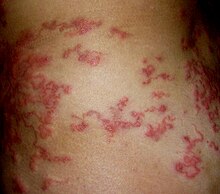Serpiginous


Serpiginous, first known to be used in the 15th century, is a term from Latin serpere (“to creep”), usually referring to a creeping, snakelike or slowly progressive skin disease.[1][2]
It is used to describe the rash in cutaneous larvae migrans,[3] erythema annulare centrifugum,[4] purpura annularis telangiectoides, ringworm,[5] balanitis circinata,[6] and some cases of bullous pemphigoid.[7]
It is also used to describe serpiginous choroiditis, a rare eye condition in which irregularly shaped (serpiginous) lesions are seen in two layers of the eye surface (the choriocapillaris and the retinal pigment epithelium).[8]
References
[edit]- ^ "Definition of SERPIGINOUS". www.merriam-webster.com. Retrieved 9 January 2021.
- ^ Oakley, Amanda. "Terminology in dermatology | DermNet NZ". dermnetnz.org. Retrieved 9 January 2021.
- ^ Newman, Ross; Newland, Jason (2012). "Cutaneous Larvae Migrans". In Schwartz, M. William (ed.). The 5 Minute Pediatric Consult. Lippincott Williams & Wilkins. p. 246. ISBN 978-1-4511-1656-4.
- ^ Koch, Karen. "Erythema annulare centrifugum | DermNet NZ". dermnetnz.org. Retrieved 9 January 2021.
- ^ Russel, James D.; O'McCall, Calvin (3 July 2015). "17. Infections in the kidney transplant recipient". In Nunley, Julia R.; Lerma, Edgar V. (eds.). Dermatological Manifestations of Kidney Disease. Springer. p. 174. ISBN 978-1-4939-2394-6.
- ^ Gupta, Vishal (2019). "A retrospective case series of 12 patients with chronic reactive arthritis with emphasis on treatment outcome with biologics". ResearchGate. Indian Journal of Dermatology, Venereology and Leprology. Retrieved 2023-02-27.
- ^ Narayanasetty, Naveen Kikkeri; Pai, Varadraj V; Athanikar, Sharatchandra B (2013). "Annular Lesions in Dermatology". Indian Journal of Dermatology. 58 (2): 157. doi:10.4103/0019-5154.108071. ISSN 0019-5154. PMC 3657228. PMID 23716818.
- ^ "Choroiditis, Serpiginous". NORD (National Organization for Rare Disorders). Retrieved 9 January 2021.